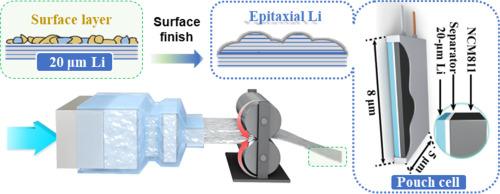Surface-finish induced textured electrodeposition on 20 μm Li-metal anode
IF 20.2
1区 材料科学
Q1 CHEMISTRY, PHYSICAL
引用次数: 0
Abstract
Implementing Li metal anode with thickness <50 μm is a key step to achieve high energy density lithium metal batteries. However, the production of thin Li-foils is non-standardized, with the supplier-dependent qualities incurring uncertainties for cell development and evaluation. Here, we demonstrate that Li-foils with varying thicknesses possess distinct surface finishes and bulk-phase textures. As the extrusion-produced 200 μm Li foils are rich in inorganic surface species and (110)-texture, the 20 μm Li produced via rolling feature organic surface species and (100)-Li texture underneath. The surface finish and foil textures are rooted in the angled shear forces and rolling lubricant. Textured Li foils are conducive to epitaxial Li deposition however the native surface passivation layer perturbs the substrate-deposits intimacy and degrades its electrochemical reversibility. Mechanical and chemical polishing were employed to refine the Li surface finish, only the latter achieves an ideal surface finish that reinstates epitaxial Li-electrodeposition. This engenders textured Li deposits, greatly improving the lifespan of lithium metal anodes. Pouch cells employing chemically polished 20 μm Li anodes and 20 mg/cm2 NCM811 cathodes exhibit capacity retention of 97.1 % after 100 cycles. The benefit of surface-finish in 20 μm Li was verified in >400 Wh/kg Ah-pouch-cells.


20 μm锂金属阳极表面光面诱导织构电沉积
实现厚度为50 μm的锂金属阳极是实现高能量密度锂金属电池的关键一步。然而,薄锂箔的生产是非标准化的,依赖于供应商的质量会导致电池开发和评估的不确定性。在这里,我们证明了不同厚度的锂箔具有不同的表面处理和体相纹理。挤压法制备的200 μm锂箔具有丰富的无机表面物质和(110)-织构,而轧制法制备的20 μm锂箔具有有机表面物质和(100)- -织构。表面光洁度和箔纹理根植于角度剪切力和滚动润滑剂。纹理化的锂箔有利于外延锂的沉积,但其表面的钝化层破坏了衬底与镀层的紧密性,降低了其电化学可逆性。采用机械抛光和化学抛光来改善锂表面光洁度,只有后者达到理想的表面光洁度,恢复外延锂电沉积。这就产生了有织构的锂沉积,大大提高了锂金属阳极的寿命。采用化学抛光的20 μm Li阳极和20 mg/cm2 NCM811阴极的袋状电池在100次循环后的容量保持率为97.1%。在>;400 Wh/kg ah -袋电池中验证了20 μm Li下表面光洁度的好处。
本文章由计算机程序翻译,如有差异,请以英文原文为准。
求助全文
约1分钟内获得全文
求助全文
来源期刊

Energy Storage Materials
Materials Science-General Materials Science
CiteScore
33.00
自引率
5.90%
发文量
652
审稿时长
27 days
期刊介绍:
Energy Storage Materials is a global interdisciplinary journal dedicated to sharing scientific and technological advancements in materials and devices for advanced energy storage and related energy conversion, such as in metal-O2 batteries. The journal features comprehensive research articles, including full papers and short communications, as well as authoritative feature articles and reviews by leading experts in the field.
Energy Storage Materials covers a wide range of topics, including the synthesis, fabrication, structure, properties, performance, and technological applications of energy storage materials. Additionally, the journal explores strategies, policies, and developments in the field of energy storage materials and devices for sustainable energy.
Published papers are selected based on their scientific and technological significance, their ability to provide valuable new knowledge, and their relevance to the international research community.
 求助内容:
求助内容: 应助结果提醒方式:
应助结果提醒方式:


